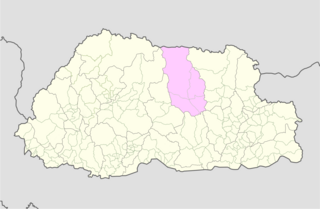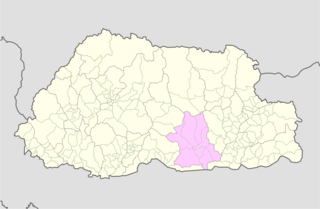Related Research Articles

Bumthang District is one of the 20 dzongkhag (districts) comprising Bhutan. It is the most historic dzongkhag if the number of ancient temples and sacred sites is counted. Bumthang consists of the four mountain valleys of Ura, Chumey, Tang and Choekhor ("Bumthang"), although occasionally the entire district is referred to as Bumthang Valley.

Zhemgang District, is one of the 20 dzongkhags (districts) comprising Bhutan. It is bordered by Sarpang, Trongsa, Bumthang, Mongar and Pemagatshel Districts, and borders Assam in India to the south. The administrative center of the district is Zhemgang.
The Sharchops are the populations of mixed Tibetan, Southeast Asian and South Asian descent that mostly live in the eastern districts of Bhutan.
The Ngalop are people of Tibetan origin who migrated to Bhutan as early as the ninth century. Orientalists adopted the term "Bhote" or Bhotiya, meaning "people of Bod (Tibet)", a term also applied to the Tibetan people, leading to confusion, and now is rarely used in reference to the Ngalop.
The Kheng people are found primarily in the Zhemgang, Trongsa, Bumthang, Dagana, and Mongar Districts of central Bhutan. They speak the Kheng language, a member of the extended Tibetan language family belonging to the East Bodish languages group; it is mutually intelligible with the Bumthang language and Kurtöp language to the north. The Kheng people are ethnolinguistically same as the Bumthang people and Kurtöp people of central Bhutan and are more closely related to Ngalop people of western Bhutan than to their neighbors in eastern Bhutan, who are primarily Sharchops and speak Tshangla language. SIL International estimates there are 50,000 Kheng speakers as of 2009.

Trongsa District is one of the districts of Bhutan. It is the most central district of Bhutan and the geographic centre of Bhutan is located within it at Trongsa Dzong.
There are numerous ethnic groups in Bhutan, but the Ngalop people who speak the Dzongkha language constitute a majority of the Bhutanese population. The Bhutanese are of four main ethnic groups, which themselves are not necessarily exclusive: the politically and culturally dominant Ngalop of western and northern Bhutan; the Sharchop of eastern Bhutan; the Lhotshampa concentrated in southern Bhutan; and Bhutanese tribal and aboriginal peoples living in villages scattered throughout Bhutan.

There are two dozen languages of Bhutan, all members of the Tibeto-Burman language family except for Nepali, which is an Indo-Aryan language, and Bhutanese Sign Language. Dzongkha, the national language, is the only native language of Bhutan with a literary tradition, though Lepcha and Nepali are literary languages in other countries. Other non-Bhutanese minority languages are also spoken along Bhutan's borders and among the primarily Nepali-speaking Lhotshampa community in South and East Bhutan. Chöke is the language of the traditional literature and learning of the Buddhist monastics.

The following outline is provided as an overview of and topical guide to Bhutan:
The Khengkha language, or Kheng, is an East Bodish language spoken by ~40,000 native speakers worldwide, in the Zhemgang, Trongsa, and Mongar districts of south–central Bhutan.
Bodish, named for the Tibetan ethnonym Bod, is a proposed grouping consisting of the Tibetic languages and associated Sino-Tibetan languages spoken in Tibet, North India, Nepal, Bhutan, and North Pakistan. It has not been demonstrated that all these languages form a clade, characterized by shared innovations, within Sino-Tibetan.
The East Bodish languages are a small group of non-Tibetic Bodish languages spoken in eastern Bhutan and adjacent areas of Tibet and India. They include:
The Kurtöp language is an East Bodish language spoken in Kurtoe Gewog, Lhuntse District, Bhutan. In 1993, there were about 10,000 speakers of Kurtöp.
Gongduk or Gongdu is an endangered Sino-Tibetan language spoken by about 1,000 people in a few inaccessible villages located near the Kuri Chhu river in the Gongdue Gewog of Mongar District in eastern Bhutan. The names of the villages are Bala, Dagsa, Damkhar, Pam, Pangthang, and Yangbari (Ethnologue).
The Chocha Ngacha language or Chochangachakha or Tsamang is a Southern Tibetic language spoken by about 20,000 people in the Kurichu Valley of Lhuntse and Mongar Districts in eastern Bhutan.
The Bumthang language ; also called "Bhumtam", "Bumtang(kha)", "Bumtanp", "Bumthapkha", and "Kebumtamp") is an East Bodish language spoken by about 20,000 people in Bumthang and surrounding districts of Bhutan. Van Driem (1993) describes Bumthang as the dominant language of central Bhutan.

The Takpa or Dakpa language, Dakpakha, known in India as Tawang Monpa, also known as Brami in Bhutan, is an East Bodish language spoken in the Tawang district of Arunachal Pradesh, claimed by Tibet as a part of Lho-kha Sa-khul, and in northern Trashigang District in eastern Bhutan, mainly in Kyaleng, Phongmed Gewog, Dangpholeng and Lengkhar near Radi Gewog. Van Driem (2001) describes Takpa as the most divergent of Bhutan's East Bodish languages, though it shares many similarities with Bumthang. SIL reports that Takpa may be a dialect of the Brokpa language and that it been influenced by the Dzala language whereas Brokpa has not.
Nyenkha is an East Bodish language spoken by about 10,000 people in the eastern, northern, and western areas of the Black Mountains. Speakers live primarily between the Tang Chuu to the east and Mangde Chhu to the west, from the town of Trongsa in Trongsa District; along Black River passes in the Trongsa District villages of Taktse and Usar; to in Ridha and Tashiding villages, and Phobji, Dangchu, and Sephu Gewogs and surrounding villages in southeast Wangdue Phodrang District.
The Kingdom of Bumthang was one of several small kingdoms within the territory of modern Bhutan before the first consolidation under Zhabdrung Ngawang Namgyal in 1616. After initial consolidation, the Bumthang Kingdom became Bumthang Province, one of the nine Provinces of Bhutan. The region was roughly analogous to modern-day Bumthang District. It was again consolidated into the modern Kingdom of Bhutan in 1907.
The Nupbi language is an East Bodish language spoken by about 2200 people in central Bhutan.
References
- ↑ Lewis, M. Pau,l ed. (2009). "Bumthangkha". Ethnologue. Dallas, Texas: SIL International. Retrieved 20 June 2022.
- ↑ TCB, TCB. "Bumthang". Tourism Council of Bhutan. Retrieved 19 June 2022.
- ↑ van Driem, George (1994). Language policy in Bhutan. In Michael Aris and Michael Hutt (ed) Bhutan: Aspects of Culture and Development (PDF). Gartmore: Kiscadale Publications. pp. 87–106. Retrieved 20 June 2022.
- ↑ Aris, Michael (1988). Hidden Treasures and Secret Lives: A Study of Pemalingpa (1450- 1521) and the Sixth Dalai Lama (1683-1706). London: Keagan Paul. ISBN 0-7103-0328-9 . Retrieved 20 June 2022.
- ↑ Ardussi, John (2004). "he Gdung Lineages OF Central & Eastern Bhutan–A Reappraisal OF THEIR Origin, Based ON Literary Sources. In Ura, Karma & Sonam Kinga (eds) The Spider and the Piglet" (PDF). The Centre for Bhutan Studies: 60-72. Retrieved 20 June 2022.